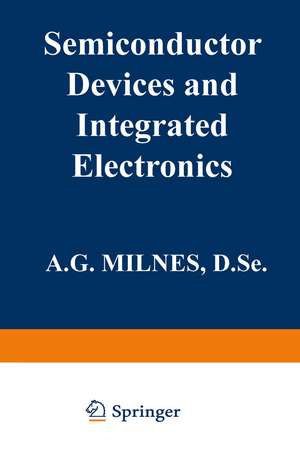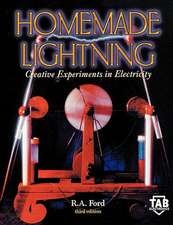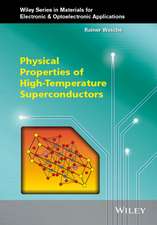Semiconductor Devices and Integrated Electronics
Autor A. G. Milnesen Limba Engleză Paperback – 19 apr 2012
Preț: 673.60 lei
Preț vechi: 792.47 lei
-15% Nou
Puncte Express: 1010
Preț estimativ în valută:
128.89€ • 134.94$ • 106.65£
128.89€ • 134.94$ • 106.65£
Carte tipărită la comandă
Livrare economică 05-19 aprilie
Preluare comenzi: 021 569.72.76
Specificații
ISBN-13: 9789401170239
ISBN-10: 9401170231
Pagini: 1024
Ilustrații: XX, 1000 p.
Dimensiuni: 152 x 229 x 54 mm
Greutate: 1.34 kg
Ediția:Softcover reprint of the original 1st ed. 1980
Editura: SPRINGER NETHERLANDS
Colecția Springer
Locul publicării:Dordrecht, Netherlands
ISBN-10: 9401170231
Pagini: 1024
Ilustrații: XX, 1000 p.
Dimensiuni: 152 x 229 x 54 mm
Greutate: 1.34 kg
Ediția:Softcover reprint of the original 1st ed. 1980
Editura: SPRINGER NETHERLANDS
Colecția Springer
Locul publicării:Dordrecht, Netherlands
Public țintă
ResearchCuprins
1 Semiconductor Junctions and Diodes.- 1.1 Introductory Semiconductor Equations and Concepts.- 1.2 PN Junction Forward Characteristics.- 1.3 Diode Reverse Characteristics.- 1.4 Junction Transient Characteristics.- 1.5 Rectifier Circuits.- 1.6 Zener Reference Diodes.- 1.7 Diodes with Negative Resistance.- 1.8 Electron Beam Bombarded Semiconductor Diodes as Amplifiers.- 1.9 Questions.- 1.10 References and Further Reading Suggestions.- 2 Metal-Semiconductor Schottky-Barrier Diodes.- 2.1 Elementary Metal-Semiconductor Junction Concepts.- 2.2 Barrier Height Measurements.- 2.3 Schottky Barrier Current-Voltage Characteristics.- 2.4 Minority Charge in Schottky Junctions.- 2.5 Schottky Barriers in Integrated Circuits.- 2.6 High Power Schottky Barrier Rectifiers.- 2.7 Questions.- 2.8 References and Further Reading Suggestions.- 3 Microwave Applications of Diodes, Varactors and Tunnel Diodes.- 3.1 Detectors, Mixer Diodes and Related Devices.- 3.2 PIN Diodes as Attenuators and Switches.- 3.3 Varactor Diodes and Parametric Frequency Multiplication and Amplification.- 3.4 Tunnel Diodes and Applications.- 3.5 Questions.- 3.6 References and Further Reading Suggestions.- 4 Bipolar Junction Transistors.- 4.1 General Characteristics.- 4.2 Voltage Rating and Second Breakdown.- 4.3 Factors Controlling the Current Gain.- 4.4 Frequency Performance and Microwave Transistors.- 4.5 Power Transistors.- 4.6 Switching of Bipolar Transistors.- 4.7 Lateral Transistors.- 4.8 Heterojunction Transistors.- 4.9 Questions.- 4.10 References and Further Reading Suggestions.- 5 Thyristors — Controlled PNPN and Related Switch Devices.- 5.1 Basic Concepts of PNPN Structures.- 5.2 Thyristor Turn-on, Turn-off and Power Considerations.- 5.3 Triacs and Other Multilayer Structures.- 5.4 Computer Aided Design Modelfor a Thyristor Circuit.- 5.5 Thyristor Applications (Brief Comments).- 5.6 Questions.- 5.7 References and Further Reading Suggestions.- 6 JFETs and MESFETs — Field Effect Transistors.- 6.1 Si FET Modeling Including Saturation Velocity Effects.- 6.2 GaAs MESFET Modeling.- 6.3 Dual Gate MESFETs.- 6.4 Microwave Field Effect Transistors.- 6.5 Some Applications of JFETs and MESFETs.- 6.6 Questions.- 6.7 References and Further Reading Suggestions.- 7 Insulated Gate-Field-Effect-Transistors: MOSFETs, IGFETs and Related Devices.- 7.1 Introduction.- 7.2 First-Order Theory of a MOSFET.- 7.3 Further Consideration of MOSFET Characteristics.- 7.4 MOSFET Saturation Models.- 7.5 The Transition from IGFET to Bipolar Transistor Performance.- 7.6 Semiconductor-Insulator and Insulator-Metal Interfaces.- 7.7 Fabrication Processes for IGFETs.- 7.8 CMOS Structures and Logic.- 7.9 Computer Aided Design of MOSFET Circuits for Large Scale Integration.- 7.10 MOSFET Switches.- 7.11 Noise in MOSFETs.- 7.12 Special Purpose MOSFETs.- 7.13 Questions.- 7.14 References and Further Reading Suggestions.- 8 Integrated Circuit Fundamentals.- 8.1 Large Scale Integration.- 8.2 Yield: The Designer’s Dilemma.- 8.3 Bipolar IC Technology.- 8.4 MOS Inverters.- 8.5 MOS Logic Circuits and Scaling.- 8.6 Future Limits in Digital Electronics.- 8.7 Questions.- 8.8 References and Further Reading Suggestions.- 9 Integrated Circuit Applications.- 9.1 Linear Integrated Circuits.- 9.2 Communications Applications.- 9.3 Applications in Watches, Cameras and Automobiles.- 9.4 Semiconductor Memories.- 9.5 Microprocessors.- 9.6 Small Calculators.- 9.7 Questions.- 9.8 References and Further Reading Suggestions.- 10 Charge-Transfer Devices.- 10.1 General Concepts.- 10.2 Loss Mechanisms in CCDs.- 10.3 Charge-Coupled DelayLines and Filters.- 10.4 Charge-Coupled Memories.- 10.5 Imaging CCD Arrays.- 10.6 CCD Logic Structures.- 10.7 Bucket-Brigade Circuits.- 10.8 Questions.- 10.9 References and Further Reading Suggestions.- 11 Avalanche-Diode Microwave Oscillators, Amplifiers, and Gunn Devices.- 11.1 Introduction.- 11.2 Read Diode Oscillator Concepts.- 11.3 Impatt Performance.- 11.4 Trapatt Oscillations.- 11.5 Avalanche-Diode Amplifiers.- 11.6 Comments on Performance.- 11.7 Transferred-Electron Device (Gunn) Oscillatros.- 11.8 TED (Gunn) Logic Concepts.- 11.9 Questions.- 11.10 References and Further Reading Suggestions.- 12 Solar Cells.- 12.1 Solar Energy.- 12.2 Silicon Solar Cells.- 12.3 Solar Cells of GaAs, InP, and Related Semiconductors.- 12.4 Cells of CdS and Related Semiconductors.- 12.5 Discussion.- 12.6 Questions.- 12.7 References and Further Reading Suggestions.- 13 Light Detecting Semiconductor Devices.- 13.1 Photodiodes.- 13.2 Detectivity.- 13.3 Photoconductive Detectors.- 13.4 Phototransistors.- 13.5 Photocathodes and Negative-Electron-Affinity-Emitting Devices.- 13.6 Vidicon Camera Tubes and Silicon Diode Array Targets.- 13.7 Electrophotographic Copying.- 13.8 Questions.- 13.9 References and Further Reading Suggestions.- 14 Light Emitting Diodes and Injection Lasers.- 14.1 Light Emission from Direct-Gap GaAs1?xPx.- 14.2 Radiative and Nonradiative Recombination in GaAs Diodes.- 14.3 GaP Light-Emitting Diodes.- 14.4 Other Light-Emitting Materials.- 14.5 Applications of Light-Emitting Diodes.- 14.6 Heterojunction A1xGa1?xAs — GaAs Injection Lasers.- 14.7 Other Injection Lasers.- 14.8 Injection Lasers and LEDs as Light Sources for Optical Communications Systems.- 14.9 Questions.- 14.10 References and Further Reading Suggestions.- 15 Semiconductor Sensors and Transducers.-15.1 Semiconductor Sensors Involving Magnetics.- 15.2 Strain Sensors and Related Transducers.- 15.3 Temperature Sensors.- 15.4 Gas Sensing Semiconductor Structures.- 15.5 High-Energy Particle and Gamma Ray Sensors.- 15.6 Questions.- 15.7 References and Further Reading Suggestions.- Book List.






